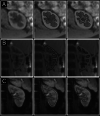Fetal growth restriction followed by very preterm birth is associated with smaller kidneys but preserved kidney function in adolescence
- PMID: 36409369
- PMCID: PMC10154253
- DOI: 10.1007/s00467-022-05785-x
Fetal growth restriction followed by very preterm birth is associated with smaller kidneys but preserved kidney function in adolescence
Abstract
Background: Preterm birth and fetal growth restriction (FGR) are associated with structural and functional kidney changes, increasing long-term risk for chronic kidney disease and hypertension. However, recent studies in preterm children are conflicting, indicating structural changes but normal kidney function. This study therefore assessed kidney structure and function in a cohort of adolescents born very preterm with and without verified FGR.
Methods: Adolescents born very preterm with FGR and two groups with appropriate birthweight (AGA) were included; one matched for gestational week at birth and one born at term. Cortical and medullary kidney volumes and T1 and T2* mapping values were assessed by magnetic resonance imaging. Biochemical markers of kidney function and renin-angiotensin-aldosterone system (RAAS) activation were analyzed.
Results: Sixty-four adolescents were included (13-16 years; 48% girls). Very preterm birth with FGR showed smaller total (66 vs. 75 ml/m2; p = 0.01) and medullary volume (19 vs. 24 ml/m2; p < 0.0001) compared to term AGA. Corticomedullary volume ratio decreased from preterm FGR (2.4) to preterm AGA (2.2) to term AGA (1.9; p = 0.004). There were no differences in T1 or T2* values (all p ≥ 0.34) or in biochemical markers (all p ≥ 0.12) between groups.
Conclusions: FGR with abnormal fetal blood flow followed by very preterm birth is associated with smaller total kidney and medullary kidney volumes, but not with markers of kidney dysfunction or RAAS activation in adolescence. Decreased total kidney and medullary volumes may still precede a long-term decrease in kidney function, and potentially be used as a prognostic marker. A higher resolution version of the Graphical abstract is available as Supplementary information.
Keywords: Adolescence; Angiotensinogen; Fetal growth restriction; Kidney function; Kidney parenchyma; Kidney volume; Renal cortical volume; Renal medullary volume; Very preterm.
© 2022. The Author(s).
Conflict of interest statement
The authors declare no competing interests.
Figures



Similar articles
-
Higher blood pressure in adolescent boys after very preterm birth and fetal growth restriction.Pediatr Res. 2023 Jun;93(7):2019-2027. doi: 10.1038/s41390-022-02367-3. Epub 2022 Nov 7. Pediatr Res. 2023. PMID: 36344695 Free PMC article.
-
Sleep: A Window Into Autonomic Control in Children Born Preterm and Growth Restricted.Sleep. 2017 May 1;40(5). doi: 10.1093/sleep/zsx048. Sleep. 2017. PMID: 28419371
-
Early-Onset Fetal Growth Restriction Increases Left Ventricular Sphericity in Adolescents Born Very Preterm.Pediatr Cardiol. 2024 Dec;45(8):1729-1740. doi: 10.1007/s00246-023-03265-z. Epub 2023 Aug 19. Pediatr Cardiol. 2024. PMID: 37596421 Free PMC article.
-
Risk of stillbirth, preterm delivery, and fetal growth restriction following exposure in a previous birth: systematic review and meta-analysis.BJOG. 2018 Jan;125(2):183-192. doi: 10.1111/1471-0528.14906. Epub 2017 Oct 3. BJOG. 2018. PMID: 28856792
-
Current and potential methods to assess kidney structure and morphology in term and preterm neonates.Anat Rec (Hoboken). 2025 Apr;308(4):1229-1250. doi: 10.1002/ar.25195. Epub 2023 Mar 8. Anat Rec (Hoboken). 2025. PMID: 36883787 Free PMC article. Review.
Cited by
-
Placental nanoparticle-mediated IGF1 gene therapy corrects fetal growth restriction in a guinea pig model.Gene Ther. 2025 May;32(3):255-265. doi: 10.1038/s41434-024-00508-3. Epub 2024 Dec 4. Gene Ther. 2025. PMID: 39627510 Free PMC article.
-
Comprehensive evaluation of fetal renal ultrasound parameters for fetal growth restriction.Heliyon. 2024 Aug 28;10(17):e36687. doi: 10.1016/j.heliyon.2024.e36687. eCollection 2024 Sep 15. Heliyon. 2024. PMID: 39286114 Free PMC article.
-
In vivo assessment of pediatric kidney function using multi-parametric and multi-nuclear functional magnetic resonance imaging: challenges, perspectives, and clinical applications.Pediatr Nephrol. 2025 May;40(5):1539-1548. doi: 10.1007/s00467-024-06560-w. Epub 2024 Nov 18. Pediatr Nephrol. 2025. PMID: 39556211 Free PMC article. Review.
-
Reduced kidney function in very-low-birth-weight preterm infants at preschool age.Pediatr Nephrol. 2025 Sep;40(9):2887-2897. doi: 10.1007/s00467-025-06731-3. Epub 2025 Mar 6. Pediatr Nephrol. 2025. PMID: 40047925
-
Early life factors and variation in adult kidney function in the Swedish LifeGene cohort.Sci Rep. 2025 Feb 11;15(1):5046. doi: 10.1038/s41598-025-88928-y. Sci Rep. 2025. PMID: 39934197 Free PMC article.
References
-
- Hinchliffe SA, Sargent PH, Howard CV, Chan YF, van Velzen D. Human intrauterine renal growth expressed in absolute number of glomeruli assessed by the disector method and Cavalieri principle. Lab Investig J Tech Methods Pathol. 1991;64(6):777–784. - PubMed
Publication types
MeSH terms
LinkOut - more resources
Full Text Sources
Medical
Miscellaneous

